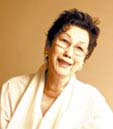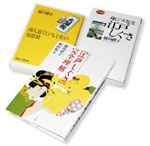|
|
|
|
|
||||||||||
HOME > the spirit of the brabd nihonbashi-bijin > Yuu:Edo-Shigusa Cultural Enrichment Ms. Reiko Koshigawa Leader of the Edo-Shigusa Narrators'Group
An aptitude for considering other people ユs feelings is the charm of Nihonbashi-bijin ムJapan Beauty from Edo-Tokyo. Now Edo-shigusa, the manners and behaviors established by the leaders of Edo, has gradually become the topic of conversation. The reason for that is because people are pursuing in natural beauty derived from the consideration and respect for others. Well-educated women of sophistication shine. So we asked Ms. Reiko Koshigawa, the recognized authority on Edo-Shigusa, about the elegant sophistication of people in Edo underlying the value of the Nihonbashi-bijin brand.
Edo-Shigusa Cultural Enrichment for Nihonbashi-bijin

Ms. Reiko Koshigawa
Leader of the Edo-Shigusa Narrators'Group
Leader of the Edo-Shigusa Narrators'Group

Mitsu-kokoro, mutsu-shitsuke, kokonotsu-kotoba,jyuni-fumi, jyugo-kotowari
People in Edo took their children's education very seriously. They did not just fill them with knowledge. Rather, they educated them in the true sense of the word, by cultivating consideration for others, which is something that all people should possess. In other words, they worked to imbue their children with what is known as Edo-shigusa.
Parents back then felt it important to raise their children in ways that were suited to their stage of growth. There is a proverb that goes, “Mitsu-kokoro, mutsu-shitsuke, kokonotsu-kotoba, jyuni-fumi, jyugo-kotowari de suekimaru,” that suggests what children should learn as they grow by the ages of 3 (mitsu), 6 (mutsu), 9 (kokonotsu), 12 (jyuni) and 15 (jyugo). By the age of 3, parents taught their children to be imaginative and sensitive to the world around them. Parents set examples of proper everyday behavior and expected their children to instinctively learn by following these examples.
By age 6, children were taught appropriate discipline through experience and frequent repetition of the actions they observed. As they became aware of their surroundings, they were taught to read circumstances and use quiet discretion when around adults, as well as to look their terakoya (private school) teachers in the eye when receiving instruction.
By age 9 they were said to have learned how to properly and inoffensively offer greetings to all kinds of people, and by age 12, they were trained to be able to replace their parents in writing letters, orders and all sorts of written materials. Children of warrior-class families, who underwent a coming-of-age ceremony at age 15, were expected not only to memorize things dealing with economics, science, and other worldly undertakings, but to have a full understanding of them as well, and this was the last stage in child-rearing.
People in Edo took their children's education very seriously. They did not just fill them with knowledge. Rather, they educated them in the true sense of the word, by cultivating consideration for others, which is something that all people should possess. In other words, they worked to imbue their children with what is known as Edo-shigusa.
Parents back then felt it important to raise their children in ways that were suited to their stage of growth. There is a proverb that goes, “Mitsu-kokoro, mutsu-shitsuke, kokonotsu-kotoba, jyuni-fumi, jyugo-kotowari de suekimaru,” that suggests what children should learn as they grow by the ages of 3 (mitsu), 6 (mutsu), 9 (kokonotsu), 12 (jyuni) and 15 (jyugo). By the age of 3, parents taught their children to be imaginative and sensitive to the world around them. Parents set examples of proper everyday behavior and expected their children to instinctively learn by following these examples.
By age 6, children were taught appropriate discipline through experience and frequent repetition of the actions they observed. As they became aware of their surroundings, they were taught to read circumstances and use quiet discretion when around adults, as well as to look their terakoya (private school) teachers in the eye when receiving instruction.
By age 9 they were said to have learned how to properly and inoffensively offer greetings to all kinds of people, and by age 12, they were trained to be able to replace their parents in writing letters, orders and all sorts of written materials. Children of warrior-class families, who underwent a coming-of-age ceremony at age 15, were expected not only to memorize things dealing with economics, science, and other worldly undertakings, but to have a full understanding of them as well, and this was the last stage in child-rearing.
Education at the Edo Terakoya
There was an elite terakoya school called Edo Terakoya that educated the male and female heirs to merchant families. In addition to reading, writing, and using an abacus, Edo Terakoya taught practical skills such as looking, listening, speaking, and thinking. They instilled rules of etiquette that allowed students to properly express themselves through their behavior in everyday situations and to have the powers of observation that would let them see past the surface of people.
In the 1940s and 50s, when American researchers did a survey of Japanese history and society, they apparently did a thorough study of education in the terakoya. They discovered that methods used in companies even today, such as brainstorming and role-playing in employee training sessions, were in use in the terakoya in Edo. For example, children would play the role of the head of a merchant family and would have to speak in that capacity or write a letter of apology upon receiving a complaint. In this way, children acted out realistic social situations at the terakoya and would then apply what they learned as they grew to become upstanding merchants versed in Edo-shigusa manners.
There was an elite terakoya school called Edo Terakoya that educated the male and female heirs to merchant families. In addition to reading, writing, and using an abacus, Edo Terakoya taught practical skills such as looking, listening, speaking, and thinking. They instilled rules of etiquette that allowed students to properly express themselves through their behavior in everyday situations and to have the powers of observation that would let them see past the surface of people.
In the 1940s and 50s, when American researchers did a survey of Japanese history and society, they apparently did a thorough study of education in the terakoya. They discovered that methods used in companies even today, such as brainstorming and role-playing in employee training sessions, were in use in the terakoya in Edo. For example, children would play the role of the head of a merchant family and would have to speak in that capacity or write a letter of apology upon receiving a complaint. In this way, children acted out realistic social situations at the terakoya and would then apply what they learned as they grew to become upstanding merchants versed in Edo-shigusa manners.

Documents provided by: Kumon Kyoiku Kenkyukai
Utagawa Toyokuni, “Furyu Terako Kissho Hajime Keiko No Zu” (Learning to write the first calligraphy of the New Year)
Nihonbashi-bijin and Edo-Shigusa
I think you can see that the Edo-shigusa I speak of, which is gradually disappearing from society, is not just a formula for decorum and manners. Edo-shigusa is more appropriately described as a combination of philosophy and actions that were created and refined by merchants in order to successfully live in Edo, a metropolis centered on Nihonbashi.
Strolling through Nihonbashi, you come across women who are dignified and alert, and who exude the beauty of body and mind that makes them deserving of being called Nihonbashi-bijin. Such enchanting women cultivate their sense of consideration for others in human relations, improve themselves through exposure to superior traditions and culture, and are continually honing their senses. I hope that many women will take the opportunity to adopt the attitude and apply the daily effort typified in the spirit of Edo to become an attractive Nihonbashi-bijin and an embodiment of Edo-shigusa.
I think you can see that the Edo-shigusa I speak of, which is gradually disappearing from society, is not just a formula for decorum and manners. Edo-shigusa is more appropriately described as a combination of philosophy and actions that were created and refined by merchants in order to successfully live in Edo, a metropolis centered on Nihonbashi.
Strolling through Nihonbashi, you come across women who are dignified and alert, and who exude the beauty of body and mind that makes them deserving of being called Nihonbashi-bijin. Such enchanting women cultivate their sense of consideration for others in human relations, improve themselves through exposure to superior traditions and culture, and are continually honing their senses. I hope that many women will take the opportunity to adopt the attitude and apply the daily effort typified in the spirit of Edo to become an attractive Nihonbashi-bijin and an embodiment of Edo-shigusa.
|



